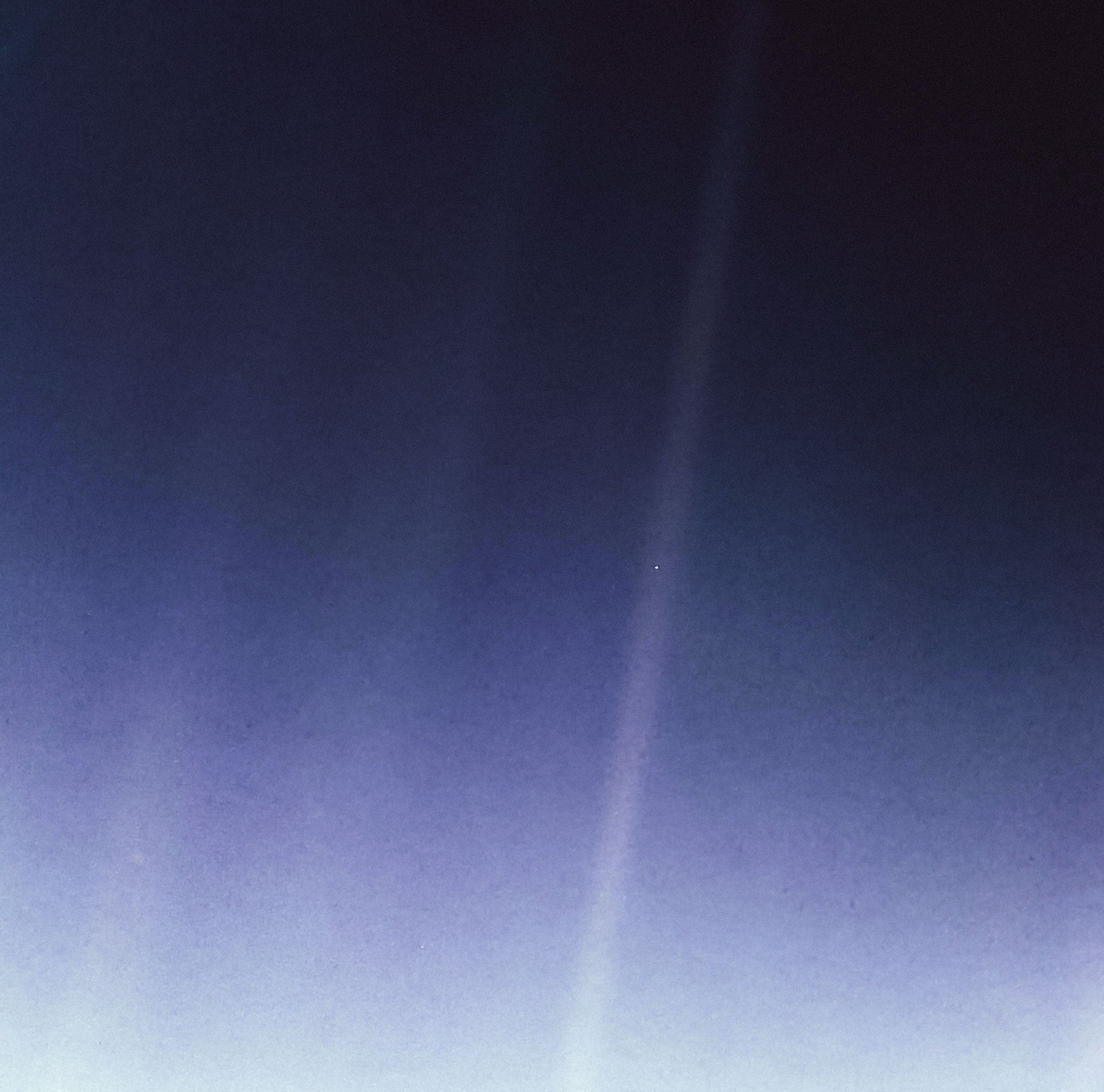Pale Blue Dot: The Science, History, and Cosmic Perspective Behind an Iconic Image
Voyager 1’s "Pale Blue Dot" photograph captured Earth as a faint speck in a sunbeam. Taken from billions of miles away, this image would become legendary for illustrating our planet’s smallness in the cosmos. In this picture, Earth is less than a pixel in size, barely distinguishable against the vast darkness of space. Yet that single point contains all of human history and everyone you have ever known: a realization that moved astronomer Carl Sagan to poetic reflection.
Voyager 1’s Long Goodbye Glimpse of Earth
In the 1980s, as NASA’s Voyager 1 spacecraft finished its tour of the outer planets, a bold idea emerged: turn the camera back toward Earth for one last photo. Famed astronomer Carl Sagan, who was part of the Voyager imaging team, first proposed this idea around 1980. He acknowledged that such a distant photo would not have any detailed scientific value: from billions of miles away, Earth would appear as just a tiny dot, but that was exactly the point. Sagan argued the image could provide a profound new perspective on our place in the universe. He and like-minded colleagues wanted humanity to see our world’s fragility: a tiny, fragile speck in the cosmic ocean.
Not everyone at NASA was immediately on board with the plan. There were technical concerns that pointing Voyager’s camera toward the Sun, near which Earth would appear in the sky, might irreparably damage the imaging system. The idea was put on hold for years. It was not until 1989, nearly a decade after Sagan’s initial suggestion, that NASA finally approved the photo opportunity. In fact, the NASA Administrator at the time, Richard Truly, personally intervened to ensure the picture was taken before Voyager’s camera was shut off. By then, Voyager 1 was beyond Neptune, on the fringe of the solar system, ready to give Earth a parting glance.
Capturing the Pale Blue Dot from 3.7 Billion Miles Away
On February 14, 1990, Voyager 1 turned its gaze back toward home. The spacecraft was about 3.7 billion miles, 6 billion kilometers, from the Sun, racing outward into deep space. Mission controllers commanded it to snap a series of 60 images known as the Family Portrait: a rare group photo of the solar system with portraits of multiple planets. Earth’s portrait was one of them. Positioned only a few degrees from the Sun as seen from Voyager, Earth appeared as a mere pinprick of light caught in a hazy sunbeam scattered through the camera’s optics. In fact, our planet was so far away that it occupied only about 0.12 pixels of the camera’s field of view: essentially a tiny crescent of light not even a full pixel in size.
To capture the image without burning out the camera, engineers took precautions with Voyager’s pointing and used spectral filters. The Earth frame was taken with the narrow-angle camera through violet, blue, and green filters, which were recombined to produce the color image. Even then, the result was mostly a grainy dark field of view. Earth shows up as a pale bluish-white dot embedded in bands of sunlight lens flare. It may not look like much at first glance, but in that little dot: “that is here, that is home, that is us” every one of us lives on that speck.
Despite its simplicity, the photograph was an arduous achievement. Voyager 1 executed the command on Valentine’s Day 1990 at 04:48 GMT, and just 34 minutes later its camera was powered off forever. The probe had no more planets to visit, and shutting down the camera saved precious energy for Voyager’s long journey into interstellar space. It actually took weeks for the complete set of images to be transmitted back to Earth: all the data did not arrive until May 1990. The resulting Family Portrait captured six planets: Venus, Earth, Jupiter, Saturn, Uranus, and Neptune. Mercury was too close to the Sun to be seen, Mars was lost in the Sun’s glare, and tiny Pluto, then still considered a planet, was too distant and dim to register. To this day, it remains the first and only time a spacecraft has photographed our home solar system from the outside.
Carl Sagan’s Reflections: A Humbling, Unifying Message
The phrase Pale Blue Dot itself comes from Carl Sagan. The image inspired the title of Sagan’s 1994 book Pale Blue Dot: A Vision of the Human Future in Space, in which he pondered the deeper meaning of that photograph. Sagan famously wrote of Earth as seen from billions of miles away: “Look again at that dot. That is here. That is home. That is us.” In that single frame, Earth is nothing more than a tiny mote of dust suspended in a sunbeam. Sagan poignantly observed that “on it everyone you love, everyone you know, everyone you ever heard of, every human being who ever was, lived out their lives… on a mote of dust suspended in a sunbeam.”
From Voyager’s distant vantage point, our squabbles and divisions lose any sense of grandeur. Sagan wrote: “there is perhaps no better demonstration of the folly of human conceits than this distant image of our tiny world.” Seeing Earth as a fragile pixel highlights how pointless our hatreds and struggles can be when contrasted with the vast cosmos. The Pale Blue Dot image carries a humbling message that we are all in this together, riding on “the only home we have ever known.” Sagan urged that this perspective should inspire us “to deal more kindly with one another, and to preserve and cherish the pale blue dot”: to protect our one and only home. His words read like poetry, and for many, they transformed a simple space photograph into a profound moral reflection on unity and stewardship of our planet.
Final Thoughts
Looking at the Pale Blue Dot, we cannot help but feel a mix of wonder and humility. It invites us to pause and reflect on the miracle of our existence against the backdrop of a nearly boundless universe. In the end, this extraordinary photograph is far more than just a scientific curiosity: it is a lasting symbol of unity, a call to care for each other and our world, and a beautiful reminder that our home, our only home, is just a tiny blue dot in an endless cosmic night.


